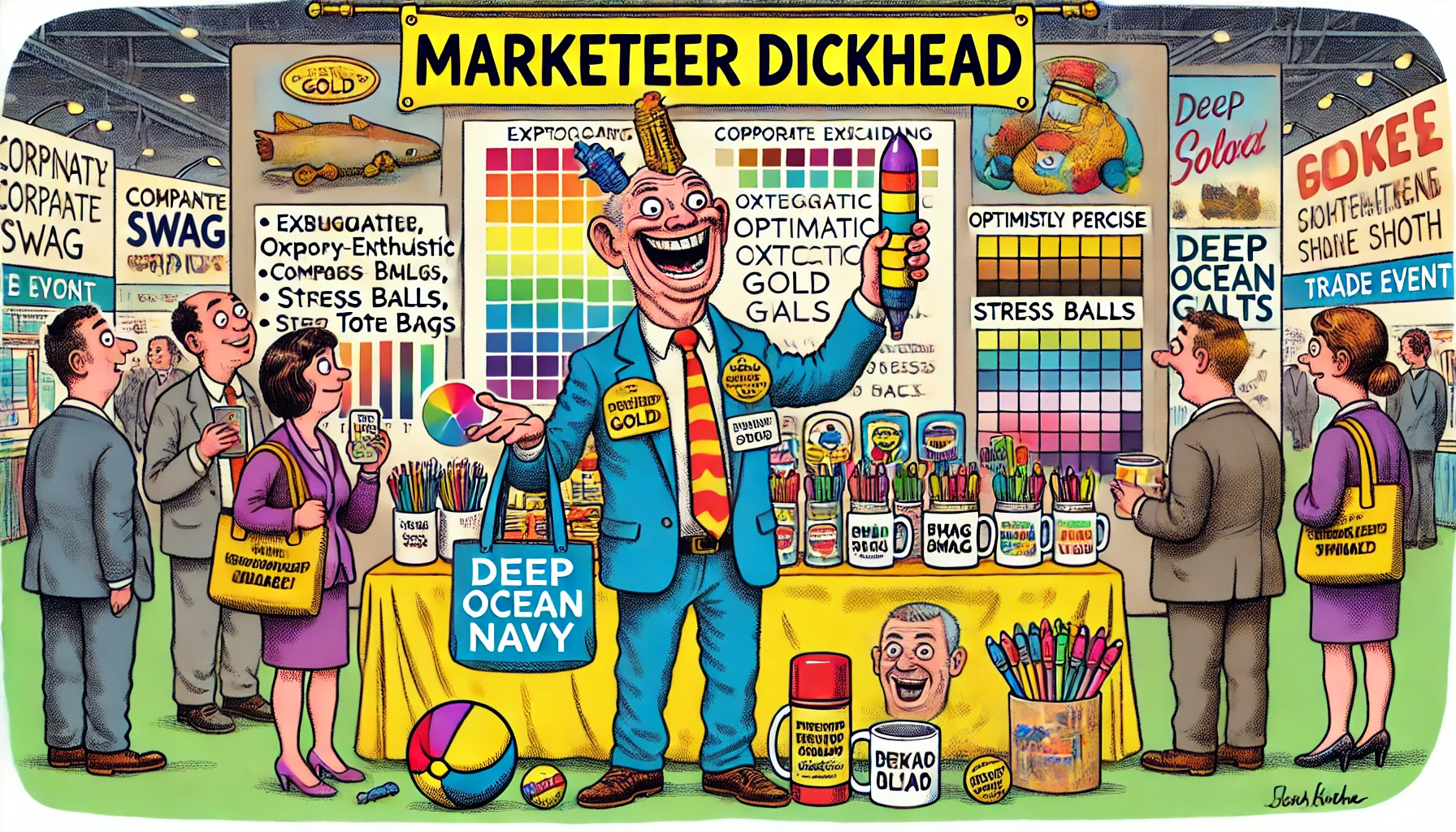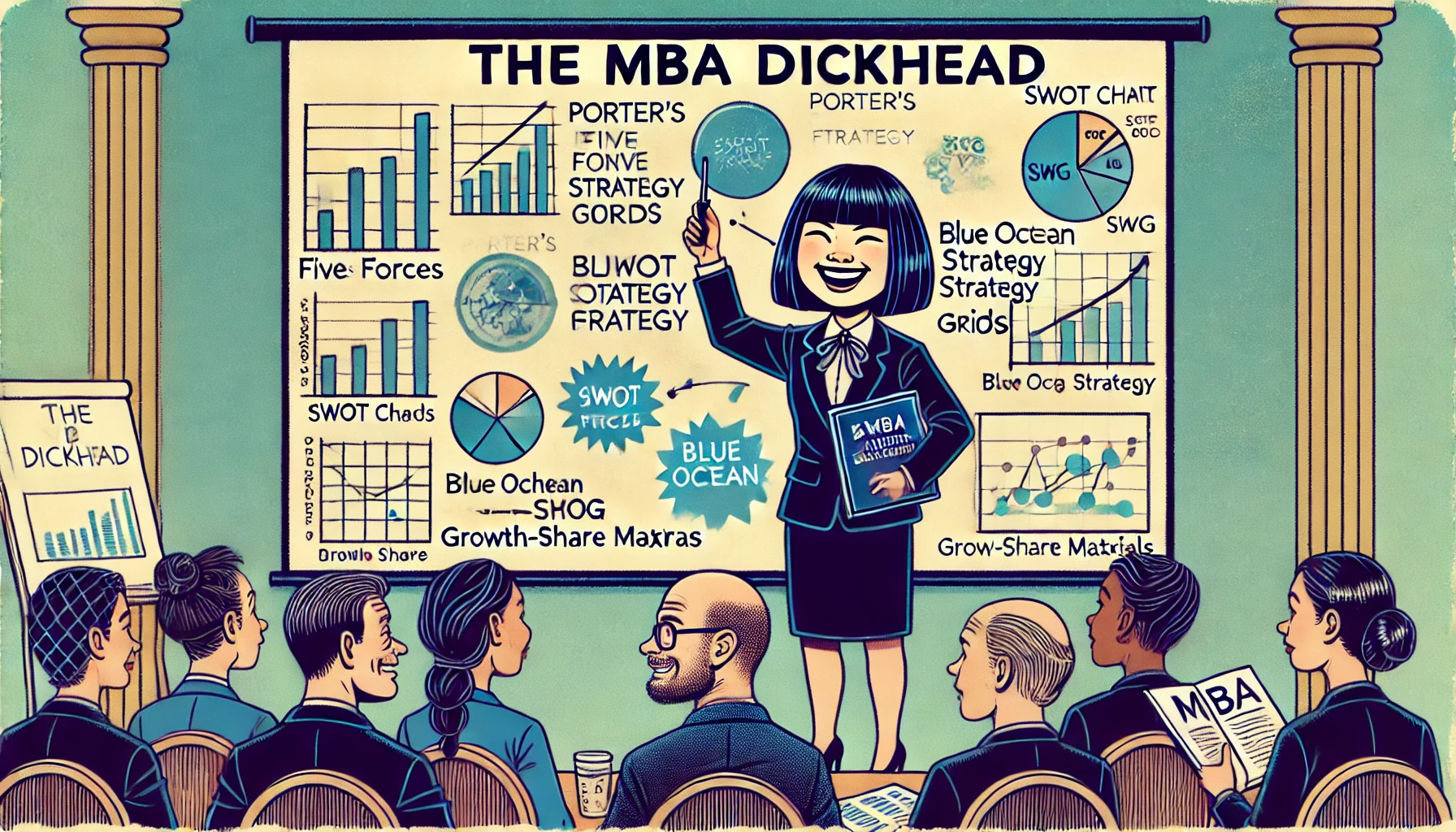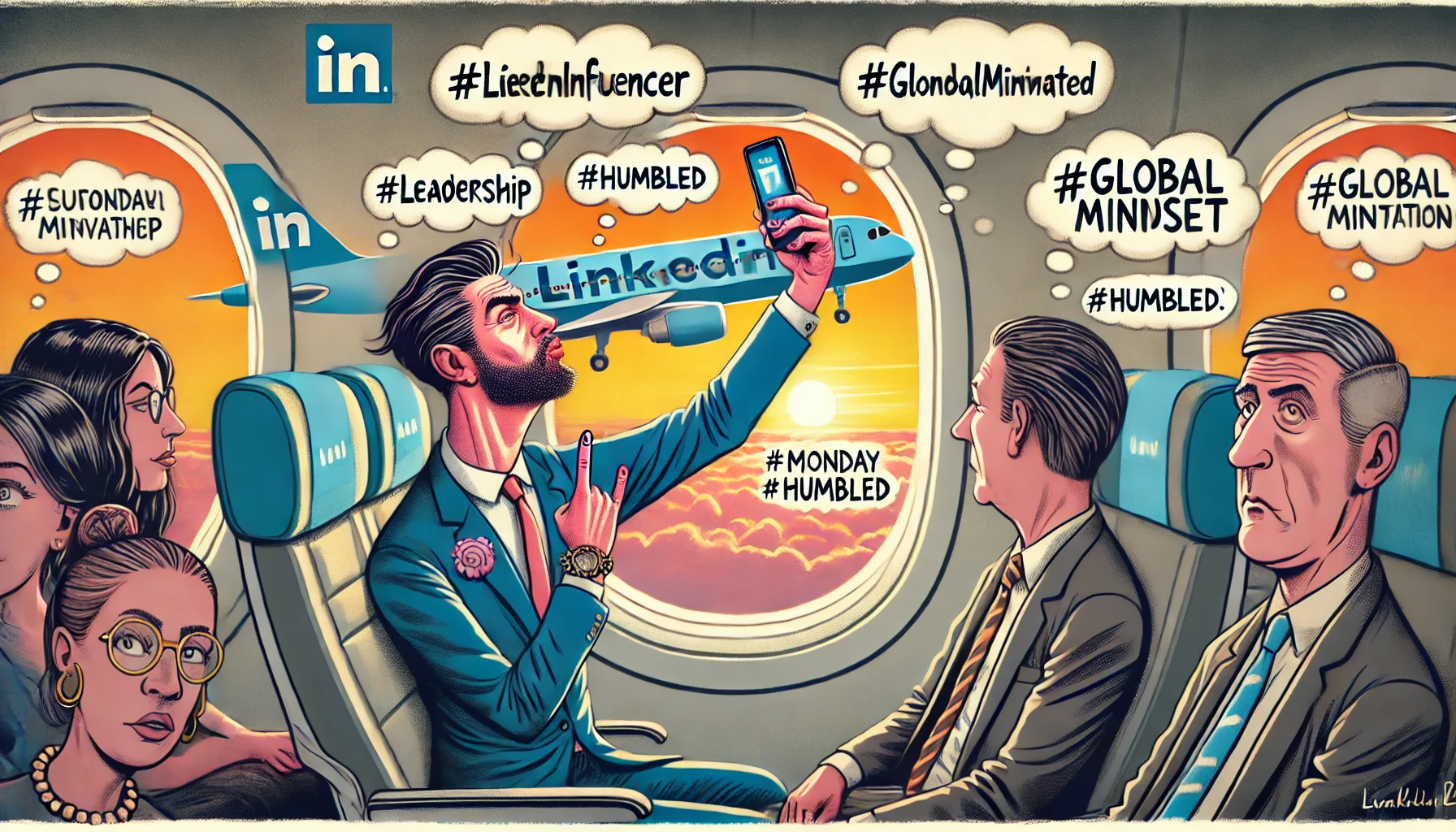Definition: The Self-Appointed Brand Guardian
Meet the Marketeer Dickhead – the self-important “brand guardian” of the corporate world. This specimen cares less about actually marketing and more about policing aesthetics. To them, fonts, Pantone colors, and logo placement are the real KPIs. They see themselves as the holy protectors of the company brand, wielding style guides and color palettes with the zeal of a medieval monk guarding a sacred manuscript. In their eyes, choosing the right shade of yellow for the company stress ball is a “strategic imperative” that somehow outweighs generating leads or closing deals. They’ll gladly host a two-hour meeting just to align everyone on the exact brand-approved color scheme, all while actual marketing opportunities wither on the vine.
For the Marketeer Dickhead, consistency is king – even if it stifles creativity and torpedoes timelines. The logo must never be a millimeter off-center, every tagline must rigidly adhere to the Tone-of-Voice Guidelines, and heaven forbid anyone use an unapproved font. They pride themselves on being the “brand police,” enforcing rules that often have zero impact on customer interest or revenue. In short, they’re so busy dotting i’s and color-matching t’s that they completely lose sight of whether the campaign is resonating with actual customers. Marketing success to them isn’t measured in leads or sales – it’s measured in how perfectly everything adheres to the almighty Brand Book.
Parody Scenario: A Day in the Life of a Marketeer Dickhead
8:00 AM – The PowerPoint Incident: It’s Tuesday morning, and you’re presenting a critical strategy update to senior leadership. You’ve spent weeks gathering data and crafting a plan to drive growth. This meeting is supposed to be about the company’s future – big-picture strategy and revenue ideas. Enter Marketing Steve, the resident Marketeer Dickhead. Halfway through your presentation, Steve’s hand shoots up. “Great deck,” he says, tilting his head with a concerned, self-satisfied smirk – the telltale sign that a ridiculous remark is coming. “Just one thing… On slide 3, the font isn’t consistent with our corporate typeface. Also, the blue in the graph? It’s a tad off – more cerulean than our approved Deep Ocean Navy.”
You blink, thinking it’s a joke. It’s not. Steve is genuinely worried that the wrong shade of blue might violate the company’s core values. You attempt to press on with real strategic discussion, but Steve isn’t done. He clears his throat: “Also, just a reminder, all slides need to follow the official template. The logo placement on your title slide isn’t exactly where we’ve specified in the brand guidelines.” Now the room shifts. Instead of talking about market expansion or competitive strategy, the discussion derails into a branding autopsy of your PowerPoint. The CFO, baffled, fiddles with her pen. The CEO, not wanting to dismiss anything “brand-related,” nods slowly as Steve drones on about font fidelity. In the blink of an eye, a meeting about revenue growth turns into a seminar on Arial vs. Calibri.
By 8:30 AM, your strategy session has morphed into a design review. Steve has successfully convinced leadership that the deck must be revamped to align with the sacred visual identity, completely ignoring that this presentation will never even face a customer. You leave the room with an action item to spend hours reformatting slides, instead of refining the strategy. Congratulations. You’ve just been Marketeered.
…and that’s just before lunch. For a Marketeer Dickhead, this is a perfectly productive morning. Derailing substantive conversations to nitpick minutiae is their forte. After all, if the presentation template isn’t obeyed, how can we possibly achieve our quarterly targets? (Never mind that it was an internal meeting.) This is a day in the life of the Marketeer Dickhead – where style trumps substance at every turn, and actual marketing work is an afterthought.
Why They Exist: Thriving in a Corporate Culture of Confusion
How does someone like our Marketeer Dickhead actually thrive in a company? The answer lies in corporate culture and a lot of head-nodding. These characters flourish in organizations where brand perception is valued more than tangible results. In such environments, higher-ups equate “marketing” with glossy brochures and pretty slides, and they assume the brand guardian must be doing something important (after all, branding sounds fancy and strategic). No executive wants to admit they don’t really understand marketing, so when the Marketeer Dickhead starts spouting jargon about “brand synergy” or “visual alignment,” the C-suite just nods along in sage agreement. The less the bosses grasp about metrics and ROI, the more cover the Marketeer Dickhead has to enforce their aesthetics-first agenda. It’s a perfect corporate petri dish for nonsense to grow.
Moreover, many companies prioritize visibility over value – if the company looks busy with big launches and rebrands, everyone assumes things are going great. The Marketeer Dickhead leverages this by focusing on highly visible projects (new logos, tagline campaigns, slick booths at trade shows) that look impressive but have no measurable impact. Because concepts like “brand equity” and “awareness” are squishy, they can claim success without anyone really challenging them on the numbers. In short, corporate structures let them thrive by rewarding form over function. When appearances matter more than reality, the person obsessed with appearances becomes king. Combine that with a dash of executive ignorance and a fear of being the one who “doesn’t get the importance of brand,” and you have the ideal habitat for a Marketeer Dickhead to survive and even climb the ladder.
How to Spot One: Red Flags in Living Color (Pantone-Matched)
Not sure if you’ve got a Marketeer Dickhead on your hands? Look for these signature behaviors and telltale signs:
-
Obsessed with Fonts and Colors: They will gleefully halt high-stakes meetings to debate font consistency or the precise hue of the header background. If you even think about deviating from the PowerPoint template, prepare for a melodramatic gasp. (These are the folks who’d hold 17 meetings just to decide which font to use in a title slide.) The company could be on fire, but they’re fixated on whether it’s Arial or Calibri in the quarterly report.
-
Company Swag Is Life-or-Death: To them, choosing the colour of the company T-shirts or gift water bottles is a matter of gravest importance. Should the swag be Sunshine Yellow or Optimistic Gold? This decision will require multiple design mockups and a task force. Expect protracted debates, sample Pantone charts circulated over email, and possibly a formal vote – all for a giveaway pen. They act like the fate of the firm rests on the exact shade of the stress ball. And don’t ever ask them to design a pin badge for employees to wear when attending events!
-
Persona Addiction: They’re bizarrely obsessed with abstract customer personas. Every customer segment gets a cute name and backstory. You’ll hear things like, “Our target is Cautious Carol, a detail-oriented skeptic who only trusts on-brand messaging” or “We also cater to Innovative Ian, an early adopter who bleeds our brand colors.”They might even invent Budget-Conscious Brad – a persona representing people who were never going to buy anything anyway. Crafting these elaborate fictional characters scratches their marketing itch, even if it has zero bearing on actual customers in the pipeline.
-
Every Response Must Be “On-Brand”: Check their LinkedIn activity. You’ll find them patrolling the company’s posts like a hall monitor. Thinking of leaving a casual comment on the company update? Think again. Every word you write must be vetted to fit the corporate tone-of-voice. They’re the ones gently reminding colleagues that your congratulatory comment on the company anniversary post wasn’t quite “on-brand.” Spontaneity is sacrilege; even internal emails might get policed for proper slogan use. Their own social media is a shrine to corporate branding – every post, every reply meticulously crafted to radiate “the brand.”
-
Endless Slogan Debates: They will burn hours – no, days – in slogan or tagline discussions. Should it be “Empowering Progress” or “Progress Empowered”? Let’s argue in circles! While the sales team is begging for viable leads, the Marketeer Dickhead is busy arranging workshops to wordsmith the tagline yet again. It’s wordplay as performance art. By the time they settle on whether the mission statement should use an Oxford comma or not, the quarter’s marketing budget is spent and nobody remembers what the original business goal was.
-
Lots of Campaigns, Little ROI: The Marketeer Dickhead is always launching some ambitious-sounding marketing campaign – a rebrand, a social media blitz, a “thought leadership” webinar series, you name it. It all creates a flurry of activity (and plenty of PowerPoints), but mysteriously, conversions and sales don’t budge. The truth is they rarely set concrete success metrics, because that would invite accountability. Instead, they’ll tout vanity metrics: “Our last campaign increased impressions by 300%!” (Translation: they put the logo on a hot-air balloon at the company picnic.) If you ask about actual revenue impact, you’ll get blank stares and a segue into how brand awareness is an investment. There’s always another flashy initiative around the corner to keep everyone dazzled – and distract from the fact that nothing’s really moving the needle.
If you see a co-worker exhibiting most or all of these traits, alert your team: you’ve got a Marketeer Dickhead in your midst. They’re easy to spot once you know the signs – just follow the trail of Pantone color swatches, one-page customer personas, and the echo of someone gasping, “This isn’t on-brand!”
How to Deal With Them: A Survival Guide for the Sane
Dealing with a Marketeer Dickhead without losing your mind (or your momentum) is an art in itself. Here’s a humorous survival guide to push past their nonsense and keep real business goals on track:
-
Refocus on Results: Whenever they derail the conversation to nitpick branding, steer the discussion back to outcomes. A great trick is to innocently ask, “I’m curious, how will changing this font color impact our sales/demo bookings/web traffic?”. This gentle reality-check can snap the room back to the actual objective. By constantly tying the discussion to concrete metrics – revenue, leads, conversion rates – you make it harder for them to justify an hour-long debate on comma placement.
-
Set Boundaries for Brand Talk: It’s important to carve out a safe zone for getting work done. One approach is to time-box the branding discussion – give it five minutes, acknowledge its importance (with a straight face), then move on. For example, “Alright Steve, let’s take 5 minutes to ensure the title slide is on-brand, then we really need to get back to the media plan.” This shows you’re not dismissing the brand outright (which they’d take as heresy) but keeps their obsession on a short leash. Another tactic: schedule a separate “branding review” meeting after the real work meeting. Often, they’ll be satisfied that a dedicated slot exists (and you can later diplomatically cancel it due to ‘time constraints’).
-
Use Data and Deadlines as Antidotes: Marketeer Dickheads thrive in ambiguity – so hit them with data or tight timelines. If they insist on a weeks-long swag color saga, come armed with a quick customer survey: “90% of customers literally do not care about the pen color – see this data. Let’s pick one by EOD.” Similarly, impose deadlines: “We need to finalize the tagline copy by Friday to launch the campaign.” Deadlines tied to real deliverables force them out of endless perfection paralysis. It also creates a convenient excuse to cut short the tenth slogan brainstorming: “We’ll have to go with Empowering Progress for now; we can always revisit later” (and “later” can be never).
-
Speak Their Language (When Needed): Sometimes, fighting fire with fire (or buzzword with buzzword) helps. If you encounter total resistance, try couching your pragmatic idea in brand-friendly terms. For instance, “Aligning our campaign with a more agile approach is actually very on-brand for us – it highlights our value of innovation.”This kind of sentence will cause them to pause, parse the buzzwords, and possibly agree because it sounded on-brand. Essentially, you’re Trojan-horsing real progress inside their own jargon. Use sparingly – you don’t want to become fluent in nonsense yourself – but it can defuse their objections by making it seem like their beloved brand principles aren’t being violated.
-
Appeal to Higher Powers (and Common Sense): If all else fails, loop in an authority who cares about results. A polite word to your boss or a senior exec about timelines being at risk can work wonders. When someone at the top says, “This campaign needs to deliver X result by Y date,” it has a magical way of dampening debates over shades of blue. Executive reinforcement of actual business goals will often put the Marketeer Dickhead back in their place. It reminds everyone that while branding is nice, making money is nicer. Also, consider enlisting allies: an outspoken sales colleague might crack by the third font debate and blurt out, “We can’t deposit ‘brand consistency’ in the bank!” Sometimes a dose of blunt truth (from someone other than you) will jolt the room back to sanity.
-
Give them a Sandbox: Finally, it can help to let them have a minor win to keep them pacified. Identify something low-stakes you’re willing to concede – like the background design of the team newsletter or the exact phrasing of the internal motto – and let them go to town with it. Think of it as giving the dog a chew toy. While they’re busy obsessing over whether the holiday party invite should say “Jolly” or “Joyous,” you and the rest of the team can get actual work done elsewhere. They feel important for safeguarding the brand on that trivial item, and you’ve averted them sinking their teeth into your big project. It’s not always ideal, but hey, sometimes survival in the corporate jungle means a little creative distraction.
Above all, maintain your sense of humor. Marketeer Dickheads are frustrating, but they’re also a bit ridiculous – remember that. Instead of banging your head on your desk, picture them valiantly defending the “sanctity of the company color palette” like a knight protecting the realm. It’s hard not to crack a smile, and laughter beats stress any day. By understanding what makes them tick and using the strategies above, you can keep your sanity intact and your projects on track. After all, brand guardians have their place – it just shouldn’t be in the driver’s seat of every decision. Keep calm, carry on with your on-brand coffee mug in hand, and navigate around the nonsense. In the end, results speak louder than fonts – even if the Marketeer Dickhead might never admit it.



